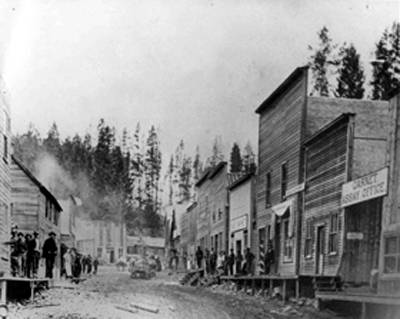We’d only had internet for a few months in the winter of 2015 when my mom asked if I’d go online and find out how to contact, if it was possible, anyone caretaking a Montana ghost town named Garnet.
Garnet, located east of Missoula, Montana, is at an elevation of about 6,000 feet. It was a mining town that boomed in the 1890s, with seven saloons, three big hotels, meat markets, grocery stores, clothing stores, general stores, a school, and a Miner’s Hall. After mining production slowed and there was a major fire in 1911 followed by World War I, the town went into its protracted death throes. In 1942, with the advent of WWII, Garnet was abandoned.
My dad’s family is from Missoula so he grew up familiar with the ghost towns in the area. My parents took my Uncle Rory and Aunt Marion, down from Alaska on their honeymoon, over a very rugged road to visit Garnet in 1976. My mother’s family had also spent some time in the area and her grandfather, Floyd Irwin, had been there in 1951 when it was a true, scarcely touched ghost town.
While my great grandfather was visiting the abandoned town, kicking through some old newspapers, he bent down to look at them. Much to his surprise he found an old Garnet grocery store “Daybook” from 1906, owned by a Frank Davey. Rather than leave it to molder and be eaten by the rats he took it home, and it was passed down to my mom, Romi, who treasured it because it came from him, but also because she loves history and ghost towns.
As a kid, I used to enjoy looking at its stained, aged cover, knowing it was a window into a bygone past, though I didn’t really grasp its significance. It was just page after yellowed page of items, names, and prices.
We weren’t sure the Garnet Preservation Association would be interested in it, since it was obviously one volume of many, but my mom wanted to return it to its origin. In my email to them I explained how we’d come by the daybook and described it:
“It’s a clothbound journal that has an account of the daily store transactions with the prices and individual tabs of locals and businesses (also the school) covering from Feb 7, 1906 – March 20, 1906 and, although weathered, it is in fair condition and readable. Interestingly, some of the items mentioned are vermicelli, canned pudding, chocolate, codfish, salmon, ‘2 cent lobster,’ and ‘boys buckle rubbers.’ You don’t come across tobacco very often, but apples, peaches, plums, blueberries, cherries, bananas, lemons, and coconuts are being sold in Feb and March. There’s a rocking chair for $2.50, three chairs for $1.35, and a stove for $10. In contrast, there was a pair of ‘Ladies shoes’ for $2.50 and 2 pairs of Ladies hose for $.50.
“There are various transactions with the Comet Mine, Lead King Ore and other mines. It also keeps track of who was given cash. Many names of locals are given.”
We sent the email off and weren’t really surprised when days, weeks, and then a month went by and nothing came of it. We were ready to shrug the whole idea off, but not before I sent a follow-up email including my parents’ phone number.
That very evening, Rita Boettcher (general manager of the Visitors Center) called back, very excited, and explained that she’d been away when our original email came and that she was thrilled beyond words to be given the opportunity to have the daybook for Garnet. They had never heard of anything like it, and certainly didn’t have any other volumes. She mentioned that they didn’t have a lot of money to purchase it, but my mom made it clear that she was simply returning it to where it belonged.
What was most exciting to them, besides being able to put on display a bona fide piece of Garnet’s history, were the wealth of names it documents. As Linda Stroh, Garnet Preservation Association Treasurer, explained: “Families are always contacting the Garnet Preservation Assoc. looking for help with their genealogy search. With genealogy, you look through the census forms, [but] with a mining camp people came and went so quickly that they may have missed the census since it’s taken every 10 years.”
She gave an example of one family that was recently helped by the daybook. “With the Harry Abbot family, they missed the census so that option was not working. But with the Davey Store Daybook, we were able to verify that his wife did go into the Davey store and buy groceries on several dates. Rita and I were able to contact the family and confirm that we could place Harry and Mary in Garnet at these dates.” Instead of sitting on a shelf as a relic in rural Alaska, it was affecting lives from all over.
Another thing that surprised and delighted Rita was that the daybook was coming from such an isolated part of Alaska, where there were no roads, few people, and we’d be sending her the book via floatplane that carried our mail once a week. She promised that the daybook would be put on display, with my parents’ names and Meyers Chuck, AK under it, in the visitor center. Something they could never have envisioned durying their past forays to the ghost town.
My parents tell me that I was five when I last visited Garnet. I have only the vaguest, dreamlike memory of it. But that seems appropriate for a ghost town where memories wander like wraiths through the old buildings.
One day, perhaps, I’ll visit again and look at the old daybook, now in its rightful home, that I once pored over as child out in the Alaskan wilderness.
Tara Neilson blogs at www.alaskaforreal.com.
Tara Neilson blogs at www.alaskaforreal.com.

